#that I can have everything uncompressed
Explore tagged Tumblr posts
Text
Rstar Resonance Part 1 FtoM conversions
This is a big post.

Female to Male conversions of the Resonance Set Part 1 By @rstarsims3 . I love lace, mesh...And come on, stockings with butterflies and musicnotes and doves! And I wanted it for my femme male sims :)
General Info
Meshes are YA-Adult Male
All accessory items are teen-elder, due to them sharing a naked body UV lay-out. So if you want your exploring teenage boy to sneakily wear a lace croptop under their shirt, you can! (My Florian - golden hair - 100% would have)
All Multipliers and normal maps are 2K textures, cus gestures wildly, annoyingly so the textures still aren't peak but maybe that's my perfectionism.
Specular Maps are a plain black tiny 32px texture
Masks are normal 1K
Everything down to the presets has custom thumbnails (See below)
Zipfile includes Custom naked bottom meshes to combine with accessory items, different from the ones included in my Woohoofy bodysuit. These have nice buttcheeks, more detail see below
You will need to enable "multiple accessories per location" with Nraas to combine some of the accessories.
I am almost an expert at baking for texture-only textures now. I've tried many settings and methods of baking for these, often still requiring repainting due to the very detailed & specific textures.
Files are uncompressed. I often discover something I like to change later on, and keeping the files uncompressed & unmerged in the upload is easier in that case. You can compress with the tool available here
Available for all somewhat sensible categories. Don't worry, no full body bodysuits in outerwear.
All morphs, including maternity.
DOWNLOAD Simblr.cc / SFS / Mediafire
Body polycounts HLOD - MLOD - LLOD:
Ken bottom: 1442, 438, 217
Bulge Bottom: 1460, 386, 189
Torso: 3232, 1450, 643
Full body: 4692, 2030, 1005
Croptop & Lace string

Taken from the babydoll dress
Meshed version & accessory version
Top & Bottom, Acc versions under gloves & socks
Meshed version has a custom normal map
1 Preset each, 2 channels (ombre, channels have same color in the presets)

Bodysuits



Bodysuit 1 is with Deep V, Bodysuit 2 with "bustier"
Meshed version & accessory version
Full body, Acc version under socks
Meshed version has a custom normal map
Meshed versions have two presets, ACC version has the two bodysuits as presets.
2 Channels with ombre
Thumbnails meshed bodysuits
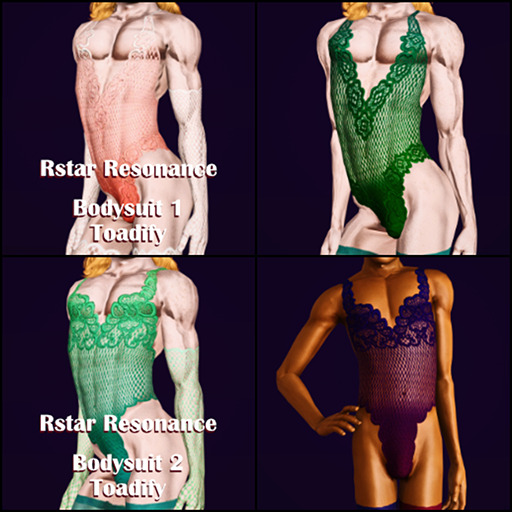
Thumbnails Accessory clothes
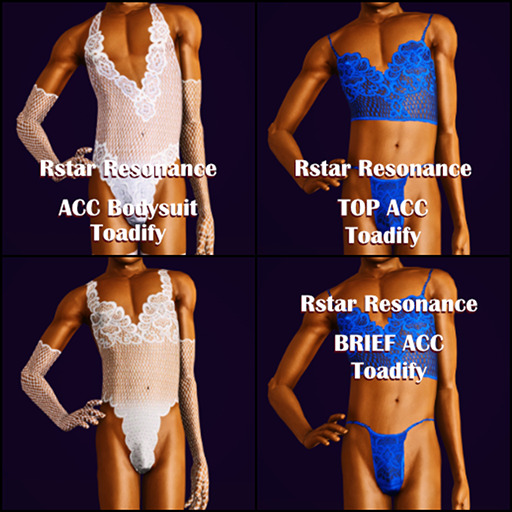
Gloves
3 Presets, two different 2-channel masks: Ombre and bicolor (left & right different colors)

Stockings
8 presets. Net, Butterflies, Musicnotes & Dove, Ombre & Bicolor each. Some presets have the two channels the same color so it looks "normal".

Bottommeshes
Naked; to be used with accessory underwear
Butt with buttcheeks comes from JVSmith Enhanced bodies on loverslab
"Ken" Version is just the JVSmith butt extracted, so all credit to him.
Bulgeversion is done from the kenversion, I added extra faces, sculpted, automorphed, edited the morphs, fixed the normals...As someone who never sees rl men half-naked, I had to look up pictures so I hope it's good! I have more of these, but picked these versions as preference & for versatility.
ML version is used in the meshed versions, Small version I gave to my brunette wearing the accessory versions.

Made with Adobe Photoshop 2025, Affinity Photo & Designer, Blender 3.6, S3PE, meshtoolkit, TSRW. Once again credit to Rstarsims3 and JVSmith
Enjoy!
@katsujiiccfinds @eternalccfinds @darkccfinds @wanderingsimsfinds @kpccfinds @pis3update
#told ya#big post#downloads: me#downloads: cas#downloads: clothing#ts3#ts3cc#Florian Pistache#luca romano#ftom conversion#rstarsims3#rstar resonance#sims 3 cc#s3cc
72 notes
·
View notes
Note
What are you currently into (or even, who? 👀)? Aside from dr :)
I AM SO GLAD YOU ASKED <3 <3 <3



i only first played the gay anguish timeloop game (in stars and time) like a month ago and!!!! its taken over my life!!!!!!!!!!!!
(numbers tangent for reference bc i love stats and im bad with words: i sat and counted them v approximately rlly quick and!! since the 27th of april i have filled 60 a5s with isat scribbles!! which include 13 bonnies, 14 miras, 20 odiles, 29 isas, ...99 siffrins and 102 loops!! ...WHOOPWHOOP!! digital art not included in the counting bc i got bored and didn't wanna recheck everything all over again )
*shoves siffrins in your face as a display of enthusiam*
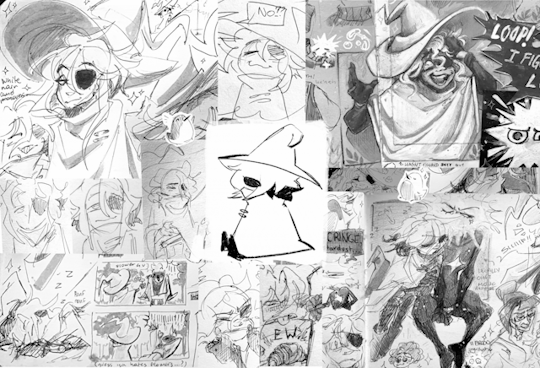
uncompressed sifs and more rambling below!! spoiler free!! (siffrin going through the horrors is the premise of the game)
im full of earnest enjoyment for isat. i am not normal about it. i will explode at any second. i really like it when the timetravel is key in the narrative and themes and brings emotional devastation and slowly dissolves a character's sense of sanity, will, self, etcetera <3!! i also like it when the FOUND FAMILY is built before your eyes and THEY BOND and have WONDERFUL DIALOGUE that i CRY ABOUT OFTEN...!! isat has both and excels at it!!!! to me!!!!!!!!!!!!
throughout the game siffrin's the one doing the timeloops and keeping his memories, they're the one going through any actual changes (and the lackthereof) yet the rest of his party, despite being reset every time, still have a sense of progression through each act- the others develop too THROUGH their perception of siffrin if that makes sense?? am i using words correctly?? yea the others can get boring and repetitive given the TIME LOOP™ circumstances but they don't get STALE and there is development while doing the same thing over and over again!! and!!! IDK!!!!!! I THINK ITS COOL!!!!!!!!!!
the sparkly cunt's my favourite and i won't be elaborating bc ✨spoilers✨!!
i need to stop rambling bc i have finals to prepare for/pretend to not procrastinate on n shit so!! uh!! pls play isat!! enjoy some siffrins!!! THANKYU FOR STOPPING BY HAVE A NICE DAY BUHBYE---

(spinfrin unleashed!!)

#in stars and time#isat#ask maiora#maiora garrulates#maiora draws#i do have other interests. also. ask me about em in like two months when i remember once again that other things exists!!#please talk to me about isat chances are ill get overwhelmed but PLEASE TALK TO ME ABOUT ISAT#/overall tone lh
159 notes
·
View notes
Note
hi hi! Long time fan of your blog—and It’s really inspired me to write my own Bruno fic, any tips for a first time bruno writer?
HELLO!!! 💕
First of all, I just want to say thank you so much!!! Your kind words have made my day—no, my month. 😭🩷 AHHH I LOVE THIS QUESTION!!!

Okay, so I have a big tip for writing Bruno, (or anyone, really,) and I learned it in Araki’s book, Manga in Theory and Practice. This is a technique he uses to make sure his characters are always acting “in-character.”
Every time Araki creates a new character, he fills out a character history sheet for them. It’s a basic sheet containing all sorts of important stuff such as their personality traits, dreams for the future, forming childhood experiences fears, etc., and he uses that sheet to figure out how his character would react to any given situation. In Manga in Theory and Practice, Araki includes a blank Character Sheet and an example of what a filled-out one may look like.
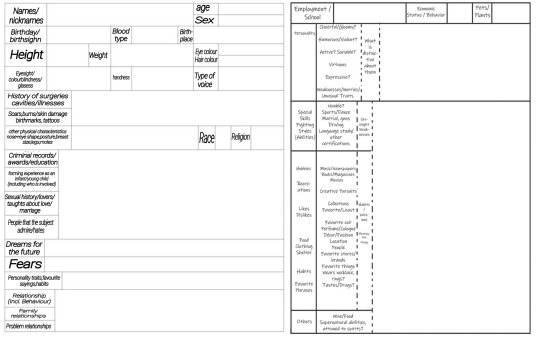
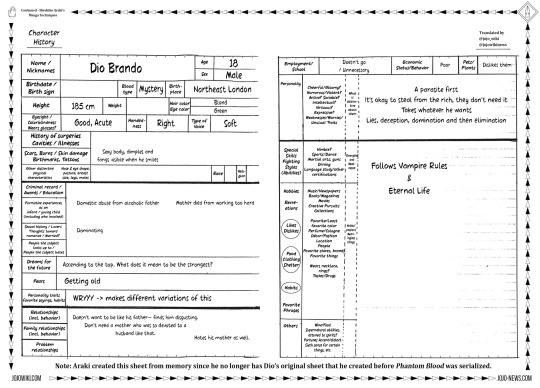
(this isn’t actually the original Dio character history sheet—Araki lost the OG. This version was made from memory. I don’t know if the original was actually this blank.)
Since Araki hasn’t released one for Bruno, I decided to make my own.
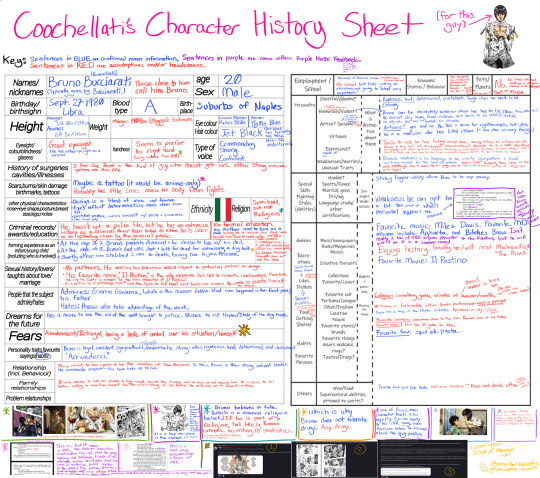
(This image is huge. HUGE. 6232 x 5519px!! Unfortunately, tumblr compressed it so you can’t read all the tiny writing :( can you tell I was an overachiever in school? Here’s a link to the uncompressed photo in Google Drive!!)
You are welcome to use this sheet if you’d like! (Anyone reading this is free to use it.) This sheet contains canon information as well as my assumptions/headcanons since Araki hasn’t given any kind of answer to some of these questions. You don’t have to agree with them. After all, everyone has their own interpretation of Bruno Bucciarati—this is just the way I see him.
Here’s how my process goes: whenever I put Bruno into a situation where I’m not sure how he’s going to react, I consult the character history chart.
For instance: what if Bruno is in a situation where he catches reader smoking weed?
This is something I haven’t always been sure as to what he’d do—I’ve changed my opinion on this multiple times. Weed is legal in many places, after all. However, after looking at my filled-out character sheet, I now have a more solid idea of how he could react.
Canon information: Bruno’s dad (his only immediate family) became injured because he witnessed a drug deal. (Which ultimately led to his death.) The way Bruno sees it, drugs killed his father. He also can get very worked up over matters that are personal to him, such as when Diavolo attempted to kill Trish, or when he caught Passione peddling drugs.
Using this information, I believe that Bruno is probably going to be very angry at reader, even if it is legal nowadays. It wasn’t very legal in 2001, and Passione likely trafficked weed on top of everything else. Sure, weed isn’t cocaine, but it was still a very stigmatized drug at the time.
(so yeah. Bruno would not be very thrilled about my love for Mary Jane… I’d quit for him. Also, this is just my assumption—it’s okay if you don’t agree with me. There are infinite ways to interpret a character, and your opinion is just as valid as mine.)
My advice to you is to fill out your own character sheet! Here’s a version that has no headcanons/assumptions if that helps :) (Unless you want to use mine, lol. But I know my word isn’t gospel, and you likely have differing opinions on him.) If you want to reword it entirely, here’s a full-res blank version!
Another reason I recommend this because you’ll really get to study his character. Being forced to think about his strengths/weaknesses, forming experiences, the relationships he has with others, or hell, even where he was born can really help form an idea of the character you’re writing. Through this exercise, I feel like I’ve gotten closer to Bruno. When it’s a character you love, filling this out feels like you’re spending time with them.
I’d also like to note that this character history chart is ever-evolving. As I continue studying Bruno's character, my opinions and mental images of him become clearer. It feels like I'm a sculptor carving a statue out of marble, gaining a more defined picture with each detail I learn. The sheet above reflects my view of him at this current moment in time, and it will likely change in the future.
Another tip I have for you relates to writing his dialogue. Bruno can be a little weird. For instance, he often speaks quite eloquently:

He’s very self-assured:
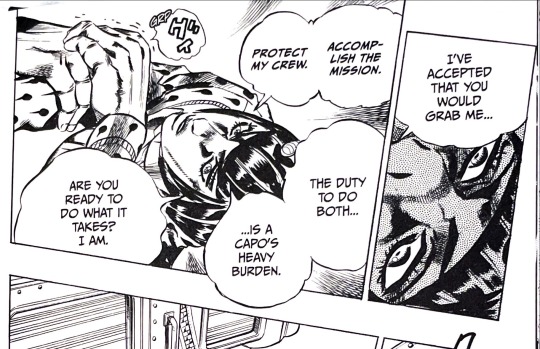
But then, there’s moments like this:

I recommend studying his speech patterns. Hell, I’m always learning more about the way he speaks.
I’ll leave you with this: In the end, there is no “right” or “wrong” way to write Bruno. How you write him is up to you, and your interpretation is just as valid as anyone else’s. Don’t worry about what others may think about your version of him—just do what feels right for you. Write Bruno the way you see fit. :)
I hope this helps!!!! Don’t forget to have fun. 💕

thanks for the ask!! <3
#bruno bucciarati#bruno buccellati#jjba x reader#vento aureo#bucciarati#jojo’s bizarre adventure#jojo no kimyou na bouken#my asks#vento aureo x reader
65 notes
·
View notes
Video
youtube
Sonic the Hedgehog CD Part 1: Sonic CD is sponsored by Marty McFly
Oh boy, now we’re getting into some spicy territory!
My history with CD is...complicated
Unlike the other Classic titles, while I was exposed to this one at around that same time thanks to the Sonic Gems Collection, I never played it quite as much due to...reasons that will become quite clear in future parts. It’s only with the release of the Whitehead version years ago that I truly dived into this game
So let’s start with the best and most obvious parts
Firstly: the opening and closing cinematics are literally some of my favorite pieces of animation ever. (Well the uncompressed versions anyway, ‘cause the Sega CD was what it was). Not just because they’re animated beautifully but because they feature what is, to me, the gold standard of Sonic’s body language.
This Sonic is quick, adventurous and fun loving when he’s zooming around, but dead serious and determined once he notices Eggman’s effect on Little Planet
But most of all: he’s cool. He’s effortlessly cool in the way he runs around and toys with badniks, while at the same time still retaining a cutesy side to him to remind you that this is still a light hearted and fun loving cartoon character
While I’m not one of those people who thinks that Sonic should never talk (specifically Classic), there is a case to be made on how in just a few minutes’ worth of animation CD is able to tell us literally everything there is to know about Sonic’s character without having him utter a single word while the Storybook games had to devote hours long narratives to get the point across. It also further lampshades just how backwards Sega’s recent handling of Classic as a character has been, focusing completely on his cutesy side while completely neglecting his cooler one, or at least downplaying it, while one of the main reasons for the switch to Modern was because they feared that Classic was being perceived as too cute by fans at the time, but whatever that’s a topic for another time
From a graphical standpoint...yeah this game is above and beyond the best of the classics, both in general spritework (though bosses in Sonic 3 actually look better, but that might just be due to that game having actual bosses that look more imposing in general), color variation, level of detail and artstyle, which is without even mentioning the way that the game manages to tell a simple yet subtle narrative through its backgrounds but I’ll focus on that at a later time
But personally I’ve...actually never been head over heels for these graphics unlike everyone else, mostly due to a personal thing, since Sonic game move so quickly it’s usually hard for me to really focus on background details and whatnot, which isn’t helped by the one thing you’ll be looking at the most, Sonic’s sprite, pretty much being ripped straight from Sonic 1 and looking so out of place compared to the rest of the game. But again: it’s not a knock against the game, it’s just me
Musically I...think it’s good, it’s certainly the most varied and smartly utilised soundtrack in the Classic games (or even in the whole series) due to how each track ties very well to the feel of not only each Zone but also each era, but personally? When it comes to Sonic music I tend to prefer more upbeat, fast paced tracks. CD’s OST is much slower and usually pretty calming and atmospheric, which works very well for what it’s trying to accomplish, it’s just not what I personally prefer to hear in a Sonic game (and yeah I’m talking about the JPN score, it’s been ages since I’ve listened to the US tracks)
On the other hand however I like all of the vocal tracks
Sonic Boom was the first I was introduced to and it still sounds great, but over time I also gained a lot of appreciation for You can do anything. The lyrics are really cheesy and are bordering on nonesense half the time, but I like the energy it has
My absolute favorite however is Cosmic Eternity. I really wish more people would talk about this one because this is, and I’m not kidding here, one of my favorite Sonic songs in general. Right up there with the likes of Open your Heart, Live and Learn and What I’m Made of. It’s just so upbeat and uplifting, it fits both this game’s happier aspects and Sonic’s character like a glove, the latter more in the sense that it sounds like something that Sonic would sing someone to cheer them up
7 notes
·
View notes
Note
how do you have models that arent on the models resource? like the idols and stuff
Theyre all my own rips! I dont use rips from tmr since qa on there isnt all that great and theyre often missing a lot of stuff (my grievances towards the-models-resource is actually partially why I started ripping things myself instead lmao)





Some behind-the-scenes of the ripping process, heres some of the assets for SFSB and Sonic Runners both pre-rip and post-dump, as well as a snippet of a SpeedSim rip dump I have yet to go through and clean up lol
Its safe to assume that unless otherwise specified all my model rips are my own! the only exception being that some early reference sheets I made were made using model rips my friend T did for me while I was having trouble with the programs we use to rip on my computer (he doesnt post his rips anywhere). Id feel absolutely terrible using other people's rips without permission and without credit
For SFSB and Dash I use a fork of AssetStudio that works on the newer versions of Unity those games use since trying to rip the assets with the original version kind of breaks everything and corrupts the textures. AssetStudio also works on Runners files as well, its just a matter of finding those files first (I had to scour the deep web and find an uncompressed file dump of the game files in an ancient forum post) because simply finding an apk wont work as the game was originally online-only and thus those files had to have been downloaded to your device's cache as the events were running before it was shut down. Thankfully SFSB and Dash's assets are in the base game so you can use an offline apk no problem!
As for Sonic Speed Simulator I cannot say how I rip things from there other than I use a scene ripper. Pretty much all scene rippers are picked up and blocked by Roblox's anti-cheat, but me and T discovered a workaround that bypasses it, which does have some questionable if not outright violation of the game's TOS, and Id rather not get in trouble nor have it patched. Sorry!
#thank you for the ask!#ask#anon#this was sent to me during the hurricane so I never got to seeing it until now aaa sorry
2 notes
·
View notes
Text
computation in DEFLATE

hey, did you know that the compression format DEFLATE can be used to simulate a cellular automaton, or do multiplication, or, theoretically, anything else you want?
a couple years ago, I had an idea for an esolang: a PNG-style image format that would "happen" to involve enough self-reference to be turing-complete. eventually, struggling to come up with a reason for the program to be split between pixel data and compression, I simplified my goal to just a turing-complete compression format, modeled after DEFLATE, the compression used in PNG (as well as in other common formats)
in thinking about this, though, it occurred to me to wonder: what could be done with DEFLATE itself? the main obvious limitation would be that an individual DEFLATE stream gets decoded in one pass, element-by-element, and then is done; it always halts, and there's limited potential for self-reference
so, in order to make computation more viable, I decided to consider an iterative process of decompression, where one DEFLATE stream is decompressed to produce another, which is decompressed again, etc; this process requires some extra behavior outside the compression format itself, but it's a minimal amount (just a basic loop)
in order for this to work, I needed a DEFLATE stream that would endlessly decompress to DEFLATE streams, so my first step was to create a DEFLATE quine -- a stream that specifically decompresses to itself. (the way I accomplished this was more complicated than necessary -- involving carefully-selected code definitions to create specific bit patterns in an otherwise-empty compressed block -- but it worked)
once I had a quine, I just needed to attach some data to it that was allowed to change. to do this, I created Kwert, a language that compiles to DEFLATE and corresponds closely to how the format works -- it has a self-modifying program consisting of "commands" that can copy sequences of previous commands (corresponding to compressed DEFLATE blocks, which work in part by copying previously-output sections of data), and then skip evaluation of some number of following commands (corresponding to uncompressed DEFLATE blocks, which output some amount of following data as-is)
I was able to create a couple interesting things with Kwert (such as a fibonacci program of sorts), but for a while I struggled to come up with a way to do anything more complex; I had a sense that it might be possible to implement a tag system of some kind -- a computational model that can simulate a turing machine using a queue of symbols, something that's well-suited for a language like Kwert that involves start-to-end modification of the program -- but I couldn't think of a way to use commands as data without them being evaluated and producing an unwanted effect
then, a couple weeks ago, I followed up on an idea I had written down previously: that commands could potentially be transferred as data without side-effects by having it so when they're being used as data, they're positioned such that all they do is copy a no-op command
using this strategy, I was able to design a system in which sections of a Kwert program simulate a string of symbols, which change over time based on preceding symbols. I created a new language, Kmid, based on this concept
Kmid, although more like a cellular automaton than a conventional programming language, is definitely easier to do things with than Kwert, and I was finally able to implement Bitwise Cyclic Tag (a simplified but equally powerful version of tag systems) and confirm that it does successfully compile to DEFLATE, which means, to the best of my knowledge, that iterated inflation is indeed turing-complete!
but DEFLATE's computational ability isn't entirely limited to that theoretical result; there are some at least somewhat interesting things that you can actually see it do (as opposed to everything being theoretically possible but not viable to execute in practice) -- you can see some programs I've written, such as the aforementioned multiplication and rule 110 cellular automaton, on github, some accompanied by instructions and/or links to the CyberChef tool to more conveniently run the DEFLATE versions
#programming#esoteric programming#esolangs#esolang#esoteric programming languages#esoteric programming language#space chirp
2 notes
·
View notes
Text
Unknown artist - Untitled
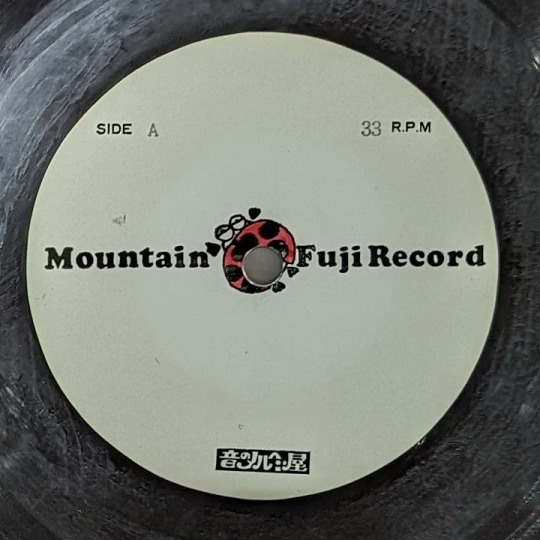
Released on, Mountain Fuji Record and recorded at Oto No Meruhenya in shibuya city (Which has sadly bin closed now)

There really isn’t much information about this record at all other than the label and the recording studio. We don't know the artist, we don't know the track titles. But we can speculate.
The album is speculated to be released between 1972 & 1975 when Mountain Fuji Record was active.
The album seems to be a collection of demos. recorded by who? You may ask, well no one knows. His voice reminds me of another Japanese folk artist though he’s much more popular. He goes by the name of Morio Agata. I think this one track from his album Chikuon Ban really shows this the most.
youtube
Obviously I don’t think they're the same person who made this record. I just think they have a very similar voice. I think the unknown artist's vocal register is a bit higher if it was somehow a Morio Agata demo acetate that would unironically be a historical discovery for folk because of how influential Morio is for the folk scene. But no i don’t think there is the same person there just isn’t enough evidence other than there similar vocals. Not only that I don't speak japanese so i would be the last person to figure that out.

This record is a must have if you want to get into Japanese private folk. It's warm but also cold with emotional raw vocals. The low quality demo feel that the record has makes it so much more personal almost like you are right in front of him while he sings his heart out. There are moments in the album where he has to cough to clear his throat which always made me feel cold while listening to it. My favourite thing about this record is how much I just don’t understand. The lyrics seem so personal yet I can't understand a single word. I tried to get people to help me understand the lyrics but it was no use. Maybe it was for the better though because my imagination goes wild whenever I listen to this record. All the songs in Japanese, except for B1 which is a cover of "El Cóndor Pasa (If I Could)" (Robles/Simon). A song about valuing movement. Not being stuck. Not wanting to be tied to one place and to not have the freedom to move around and make changes. I wonder if the other tracks in the album have meanings like that.
My personal favourite tracks are:
A2
B3
A3
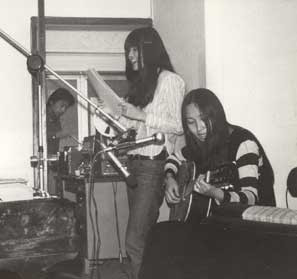
I would really like to thank the person who archived this record “banana” (banana420) . He has a youtube video with the full album and not only that, an almost uncompressed download to the full album in Flac. Which is absolutely amazing. I'm so glad there are people who are willing to go all out spending money on rare records and not only do that but make it public is just beautiful!
I would really like to thank the person who archived this record “banana” (banana420). He has a youtube video with the full album and not only that, an almost uncompressed download to the full album in Flac. Which is absolutely amazing. I'm so glad there are people who are willing to go all out spending money on rare records and not only do that but make it public is just beautiful! I think it just shows how obscure this record is that the person who owns the album doesn't even know much about it too.
youtube
This is one of my favourite Japanese folk album's and i enjoyed writing everything i know about it.
3 notes
·
View notes
Text
Why the iPhone Aux Connector Data Cable (Type L with DAC) Is the Must-Have Audio Upgrade for 2025

In 2025, mobile audio is no longer just about convenience — it's about quality, clarity, and seamless integration. Whether you're an audiophile, a casual listener, or someone who simply appreciates immersive sound on the go, upgrading your setup has never been more relevant. Enter the iPhone aux connector data cable (Type L with DAC) — a game-changing solution that bridges Apple’s evolving hardware with high-fidelity audio needs.
But what makes this sleek, compact cable the must-have accessory of the year?
The Rise of High-Resolution Audio in 2025 Music streaming services like Apple Music and Spotify HiFi are now pushing lossless audio and high-resolution formats as the new standard. However, most Bluetooth solutions—even the latest codecs—fall short of delivering truly uncompressed sound. That’s where a high-quality aux connector for iPhone sound system becomes crucial.
The Type L to 3.5mm aux connector with built-in DAC (Digital-to-Analog Converter) ensures that audio signals remain crisp, accurate, and free from digital compression. This is the secret behind deep bass, crystal-clear vocals, and balanced mids — things Bluetooth just can't deliver consistently.
Why Type L Matters in 2025 Unlike traditional straight connectors, the Type L design is engineered for convenience and longevity. With a 90-degree bend, it fits snugly against the phone, reducing cable strain and offering a streamlined look. It's especially handy for commuters, travelers, and even gamers who need clean cable management without interfering with their hand position or pocket space.
When paired with a premium iPhone aux adapter for headphones, the Type L connector brings style and function together — a must in today’s design-conscious tech ecosystem.
Built-In DAC: The Game Changer Not all cables are created equal. The standout feature in modern iPhone aux connectors is the integration of a high-quality DAC chip. Apple removed the headphone jack, but that doesn’t mean users must settle for low-quality dongles or generic adapters.
A DAC-equipped aux cable bypasses your iPhone’s digital limitations and converts audio at a much higher bit rate and sample rate. This results in smoother highs, tighter lows, and a fuller soundstage — ideal for everything from audiobooks and podcasts to studio-quality music playback.
It’s also worth noting that the DAC ensures signal stability, reducing interference, static, and volume dips — common issues with cheaper alternatives.
A Premium Audio Experience Without the Bulk One of the reasons the Tunez CB-90 and similar products are gaining traction is the balance between portability and performance. With no need for bulky amplifiers or external converters, users can enjoy plug-and-play audio with minimal effort.
If you use high-impedance headphones or connect your iPhone to a home or car stereo, having a premium iPhone aux adapter for headphones makes a noticeable difference. You don’t just hear the music — you feel it.
Who Needs It? Music Enthusiasts: Unlock the full potential of your favorite tracks in studio-level quality.
Commuters & Travelers: Enjoy uninterrupted audio with a compact, tangle-free setup.
Professionals: Take Zoom calls or record voice memos with consistent audio performance.
Gamers & Streamers: Hear every detail and get competitive with latency-free sound.
Final Thoughts The iPhone aux connector data cable (Type L with DAC) isn’t just another accessory — it’s a lifestyle upgrade in 2025. As digital audio continues to evolve, users are demanding more than wireless convenience. They want fidelity, durability, and design — and this cable delivers all three.
Whether you're connecting to headphones, car stereos, or professional sound systems, investing in a high-quality aux connector for iPhone sound system ensures you get the most out of every sound byte.
So if you're ready to elevate your iPhone audio game, this is the upgrade your ears have been waiting for.
FAQ's
Q1. What is an iPhone aux connector with DAC? A: It’s a cable that connects your iPhone to 3.5mm audio devices and includes a built-in Digital-to-Analog Converter (DAC) for high-quality sound output.
Q2. Why is a Type L aux connector better? A: The Type L design reduces cable strain, fits snugly against the iPhone, and is more convenient for daily use—especially while traveling or gaming.
Q3. Do I need a DAC in my iPhone aux cable? A: Yes, a built-in DAC ensures clearer, lossless audio by converting digital signals to analog with higher fidelity than regular adapters.
Q4. Is this suitable for car and home stereo systems? A: Absolutely. A high-quality aux connector with DAC provides stable, premium sound for both car and home audio setups.
Q5. Will it work with all iPhone models? A: It works with any iPhone that uses a Lightning port, including the latest models, as long as the connector is Apple-compatible.
0 notes
Text
The environment shifts off-course - all of us in it, tilting. In the windswept non-land that waits for us, when everything is quiet, some records will have been kept, and some discarded. In chaos everything goes into the fire. I have spent years information gardening, collecting information and words like a small nest-building bird. Saving it on solid-state hard-drives. But if the mullein won’t survive, neither will my hard-drives. In the windswept non-land that waits for us, when everything is quiet, who will be the librarians? Who will dust the switchboards and make sure the CPU fans don’t get clogged with spiderwebs? Who will creak open the doors to AWS storage units, with their rows upon rows of flickering server stacks, and carefully sweep the floors, and leafblow the front? Who will count it all up? Who will compress, uncompress, checksum, validate the JPGs? Who will check it’s all still there after a heavy storm? Can anyone ensure the PDFs are uncorrupted? JavaScript stays updated?
Myrtle Cross, sisters of the server room
1 note
·
View note
Text
How to Elevate Your Music Journey with Technology
The fusion of music and technology has transformed the creative landscape, enabling artists to reach new heights. From setting up a professional home studio to maximizing social media platforms, leveraging the right tools can make your journey smoother and more impactful. Whether you're an aspiring musician or a seasoned creator, understanding the potential of modern resources is essential for success. This guide dives deep into essential techniques that can enhance your music journey, covering everything from crafting lyrics to integrating social media into your strategy.
Building a Cost-Effective Home Studio
Creating music from home has become more accessible than ever before, thanks to affordable tools and equipment. Knowing how to set up an affordable home studio is the first step toward professional-quality production. Start by identifying your needs, such as a quality microphone, audio interface, and soundproofing materials. These basics will help you create clean recordings with minimal background noise. Software plays a crucial role, too, with digital audio workstations (DAWs) offering powerful tools for mixing and editing. Remember, an efficient setup doesn’t require a massive budget; it requires smart investments in essential gear.
Perfecting Your Tracks with WAV Files and Lyrics
High-quality audio is non-negotiable for any musician. WAV files are the gold standard, known for their uncompressed, lossless sound quality that captures every nuance of your performance. But there’s more to these files than just pristine audio; incorporating WAV file lyrics can make your music more engaging and accessible. Lyrics embedded in WAV files allow listeners to connect deeply with your work, whether they’re following along during playback or singing along with every word. This approach enhances the listener experience while making your music more memorable.
Promoting Your Music on TikTok
TikTok has quickly become one of the most influential platforms for music discovery. From viral dances to catchy hooks, the app has launched countless tracks into stardom. If you’ve ever wondered, "Can I add a link to TikTok video?" the answer is a resounding yes. By adding links to your TikTok content, you can direct viewers to your music on other platforms, expanding your reach and fostering a dedicated fanbase. This strategy not only boosts visibility but also creates opportunities for cross-platform engagement, making it an essential tool for artists in the digital age.
Showcasing Your Personality on Instagram
Social media isn’t just about promotion; it’s about connection. Instagram offers a unique way to blend personal branding with musical identity. A simple yet powerful feature is learning how to add a song to Instagram bio. Adding a song to your bio can convey your mood, highlight a recent release, or simply express your personality. It’s a subtle way to invite visitors into your world while promoting your music. The more relatable and authentic your bio feels, the stronger your connection with followers will be.
Managing Links and Creative Resources
With so much happening online, managing your resources effectively can feel overwhelming. Do you know how to save a link? Whether it’s bookmarking inspiration for your next project, saving articles for later reading, or organizing your promotional links, this skill is invaluable. Keeping your links organized ensures you stay focused and don’t miss out on opportunities to revisit essential resources. For musicians, having a well-curated library of ideas and tools can be the difference between good and great content.
Conclusion
As a musician, mastering the tools of the digital age is critical for standing out in a crowded industry. From setting up an efficient home studio to strategically using social media, small adjustments can have a significant impact on your career. By combining high-quality audio production with savvy online promotion, you’ll be well on your way to reaching a wider audience and achieving your musical goals.
0 notes
Text
You don't even need a cassette tape recorder either. Just plug the audio output of your computer into the line-in/microphone port on your computer with a short cable. Then, just simply open any audio recording app for a much better quality.
If you want the best quality, use SPDIF or an external audio interface. I wouldn't be surprised if we didn't have devices that act as USB audio interfaces while saving everything that they receive as well.
You could probably extract uncompressed multi-channel audio directly from HDMI as well if it isn't encrypted with HDCP.
Just make sure that you don't play what you're recording while you're recording it so that you don't get a feedback loop.
The cassette tape recorder is useful for adding distortion to your music, though, if you like that. Otherwise, there are portable digital voice recorders that are more compact with much better quality than tape can ever hope to achieve.
Also, since tape is completely analog, you might be able to record coax SPDIF signals directly onto the tape if it can keep up. That might be interesting to see if it's possible to play them back on a receiver.


Time shifting
––
I wanted this but the original poster is transphobic
94K notes
·
View notes
Text
Compression.
Start out by saying compression is bad in audio. It is a reduction in dynamic range of a recording. Dynamic range is a ratio of the quietest sound to the loudest sound. The basic argument for having more bits in a digital signal is more dynamic range. A really good LP can have a dynamic range of almost 60 db. CDs far more and 24 bit digital sources far far far more.
In the old days of AM Radio new songs were compressed to sound better on cheap receivers like in a car or small portable things. Those had limited dynamic range and the producers wanted the new songs to get noticed, fast. In disco days clubs were loud places and everything had to be loud. So it was.
In our new days producers for streaming also want the same thing as the target market is people listening with ear buds and smart phone speakers. So even though high bit-rate or large numbers of bits is bragged about if the produced song is compressed you will only hear the equivalent of 8 bit or even less.
Another term of similar intent is loudness equalization. The purpose is to get noticed. Making something that sells helps the business model.
Maybe I should go back and say why dynamic range compression is bad. Imagine you are having a conversation with a person who is always shouting. There is no quiet with louder for emphasis, it is all loud. In a noisy bar you may have no alternative for a conversation, but at home over dinner not right at all. Music either pop songs or jazz tunes, or symphony orchestras are conversations. You are being told a story. A lovely woman whispering in your ear is quiet. Her screaming is not. Both deliver a message. Always screaming is a message all by itself.
Many classic songs start out quiet and build. It is part of the drama. Quiet draws you in. OK I hope that is clear enough.
There is no point in bragging about how many bits you have if you throw them away with compressed streams.
It is not just digital stuff. Back in the Jurassic era of vinyl much popular music was compressed to sound good on poor systems. I have a Carly Simon Album that is compressed so much I cannot stand to listen to it. Back in the day you could buy devices to uncompress signals made by a company called dBx. I had two of those once. They helped a bit.
Classical music and Jazz were usually not so compressed as they were not popular and were for a different audience. The kind of audience that wanted to hear things clearly.
To be fair many LPs were compressed to fit more stuff on a side. Usually it was not too much and it was the decision of the mastering engineer. I have that A&M audiophile sampler with a track from Gino Vannelli that my wife had the original album of. The original was compressed just a bit compared to the audiophile track.
Compression can be done by mathematical algorithm in the digital realm or electronically using special devices like dBx circuits. It can also be done by limiting and deliberate clipping. Those effects create distortion but if that is the sound people want.....
There are more places that can compress signals. Non linear gain devices in zero feedback circuits can compress signals if the gain curve is one way and expand it if it curves the other way.
Speakers can also compress a signal as there is a force that resists displacement of a cone or diaphragm as it moves. Better speakers do that less. Both of those things are usually very very subtle. One of my arguments for POWER is that a big amp will preserve more dynamic range with a speaker.
Hey if you like a song that is streamed from Spotify good on you.
0 notes
Text
HDMI wiring and pinout
Much like USB, HDMI has several different types of plugs and ports.
Type A is the standard one. A trapezoidal port with two rows of pins, top and bottom, totals 19 pins. It can be found anywhere, from gaming consoles to CCTV servers and TVs.
Type B, Dual-Link. The same height, but twice the length of type A, hasn't been used in any products.
Type C, mini HDMI. A scaled-down version of the original port is intended for portable devices like laptops.
Type-D, micro HDMI. Even a smaller version looks like a mini USB plug. It is used in GoPros and ultra-portable computers the size of a Macbook Air at the time (like the Asus eeePC or various Windows 'ultrabooks').

Every single type of HDMI port (except the dual type B one) has a total of 19 pins. The first eight are for data, and the rest are for power, clocks, and additional functions. That means the most basic functions of video transmission can be carried out by just five pins. MHL, or Mobile HD Link, is a way to wire an HDMI plug to a micro USB. This brings the number of wires to the absolute minimum, with one data lane and one bus for everything else.

Not to bore you with another pin assignment diagram, compare this to the sheer number of functional blocks and lanes in a powerful HDMI transmitter chip.

This brings us to understanding HDMI standards, as they differ not just by the resolution of uncompressed video but by all the additional functions. HDMI has the same confusing cable category naming scheme as USB does with 'High-Speed' and all the way to 'Premium High-Speed with Ethernet'. I don't recommend using those, as looking at just the HDMI standard number is much simpler. The second caveat here should be not to buy any equipment or cables with an HDMI version less than 1.4, as it is already too old and limited.
HDMI 1.4 is suitable for FullHD video with essential ARC and CEC (in the post on HDMI functions).
HDMI 2.0 means 4K with some limitations, namely, no 5K or ultra-wide 2160p at 60 fps and no 4K60 with dynamic HDR. HDMI 2.0 has several great functions but are not all available simultaneously.
HDMI 2.1 spares no expense and provides all the quality imaginable because its bandwidth is three times higher than the one in the previous major version of the standard.
So, what's the difference between cables if they all have the same number of conductors and some plastic covering them? Simple: it's all about materials, meeting the specifications, and having some overhead.
First of all, we should be sure that all the pins are connected to wires. This is neither a joke nor an exaggeration. The right thing to do is to check them with a cable tester. But it is usually easier to check all the additional functions that manufacturers list, then go to Wikipedia and check if all the pairs are used for these functions. If the manufacturer cuts costs or makes a thinner 'easier to work with' cable, it can be a red flag and a sign that fewer wires are used. The HDMI standard specifies video transmission and not all the additional functions, meaning some wires can be absent from the cable.
Then, there's conductor thickness. There is no way to indestructively measure it at home, so the advice is the same: pick a thicker one, as it hopefully represents thicker cores, firmer insulation, and proper shielding. Moreover, in terms of meeting the specification requirements, thicker cable gives more slack to the manufacturer. Wires are typically 28, 26, or 24AWG for different lengths of cables, but this number is not always on the box or the website. Please remember that longer cables should be thicker than shorter ones. By the way, this is exactly the case for buying HDMI over twisted pair extenders. As HDMI cables become longer, thicker, and exponentially more expensive to sustain the same video quality, Ethernet cables could solve this problem.
A good practice is to pick shorter cables, 6 to 10 feet since the percentage of faulty cables is higher in the 10 to 20-foot range. The price difference between high-quality branded and generic OEM 15-foot cables makes it harder for a regular consumer to choose the more excellent option.
Canadian PC enthusiasts at LTT did the tests and discovered that no other gimmicks matter. Specifically, they've proven on a large pool of cables that something seemingly important, like gold-plating the jacks or using silver-plated wires, does not affect the results significantly. A few hundred dollars more for extra-finicky wires does not affect the video quality, just the user's perception.
To sum this all up:
All the HDMI ports are equally acceptable.
Thicc and round HDMI cables are more reliable than flat or thin ones. The same goes for the plugs; it's always better to use regular straight connectors than 90-degree-angled ones.
It's a good rule of thumb to treat HDMI version numbers 1.4, 2.0, and 2.1 as corresponding resolutions: 1080p@60, 4K@30, and 4K@60.
The more actual HDMI functions listed, the better.
Try to pick 10-foot cables or shorter from reputable brands.
====== Eugenio S
0 notes
Text
Heeyyy, it's been a looong time... *checks date* Again. It's been almost a month since I last put something on this blog. I've been really busy. being dead. And I haven't been playing Portal 2. But I have been playing a lot of the classic Sonic games via the Mega Collection, the absolutely incredible compilation disc. I think it tops Sonic Origins (which I haven't played). I feel like the comics and older illustrations, commercials, and Ristar (pronounced "Rye-star" or "Wrist-ar"? Or "Ree-star"?) win me over. And also, from what I've heard and observed, there wasn't as much love and care put into it, so the overall quality experience is hindered because
Money money money Is all you need
( Did you know ALL models of the PS3 can play PSX discs? I've been playing my newly acquired PaRappa the Rapper, too. I now own the trilogy. Only UmJammer Lammy is digital. I bought PaRappa 2 physically at my first gaming convention back in 2018, only to find out later my wife can't use PS2 discs. Big sad. You might saying "why don'tcha just jailbreak it?" I wouldn't, but even if I wanted to, I don't have the correct model. It's been so many years anyways, I wouldn't have her any other way :3 )



AND. It was with this compilation that--after all these years--that I finally achieved: 1) Beating Sonic 3D Blast (with the emeralds) 2) Beating the first level of Sonic Spinball (I've recommend some guy on YouTube having also done this, so good for him) These may not mean a lot to you, but to me? Man. And y'know what? I actually enjoyed my time with 3D Blast. It was a...unique game. I really like seeing all the sights and how the game progressed after Green Grove. After Rusty Ruin, I noticed Tails' and Knuckles' locations became way less hidden. Rusty Ruin Act 2, I think it was, had THE BEST hidden location, for Tails it might have been. No, scratch that--the whole ZONE has the best locations, you really have to go out of your way for them. What's that? ... Where did I find him? Pssh, I'm not telling you, play the game and use your brain. Just don't spin yourself around too much tryna find him. Anyways, I've been busy doing things. I've been developing a under-HTML-construction digital portfolio of almost all the art I've posted on Tumblr since uuuhm late 2020. You can find it through the link below: > the link < I'm beginning to have second thought about this one, too, so don't expect me to keep it for too long. Parallel to that, I've been trying animation again. Look guys look it is my greatest achievement: wario land 4 for the gameboi advanced. incrredible incrrrEedible- look guys look
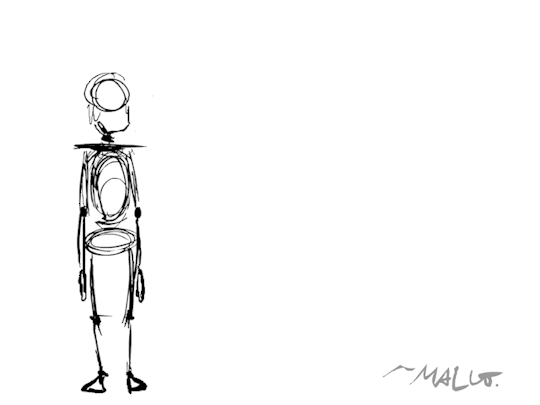
Sigh...y'know, getting guud learning basic anatomy and figure drawing can spark an improved journey... This isn't the "true animation". What I mean is each of the original drawings were MUCH larger than my Flash Document canvas (1440x1080), so by compressing everything into a Graphic symbol, I was able to minimize all the frames at once to fit. It took a few tries to work, so I had to be conscientious as to not save over the "uncompressed" drawings. k cya l8r
0 notes
Text
Related point of discussion because I don’t know what’s up with this but I’m curious if any one else does.
What’s up with many of the most common (and the most affordable) binders you’ll find being a slip-on sort of situation with no way to open the garment up with clasps or something similar; and then the instructions for putting it on saying you absolutely MUST put it on by stepping into it while it’s inside-out, pulling it up to your waist, and then inverting it, putting your arms through, and pulling the shoulder straps into place?
It’s a relatively rigid, compressing garment. That is being put on someone who presumably went through an estrogen-based puberty.
Like really let that sink in for a sec. Picture a hypothetical feminine body that someone with gender dysphoria might be trying to escape from. (Not that you need to have dysphoria to bind. No one come at me.)
I highly doubt that for a vast majority of binder-wearers, the circumference of their hip bones is less than or equal to the circumference of their compressed chest. For a solid percentage, I’m sure that is the case. But definitely not for all of us, and I bet not for over like 65%, surely.
I know for certain it’s not all of us because this is my experience.
Measuring right now, with my best, comfiest binder on, the circumference of my chest is 31”. Uncompressed and after taking a deep breath, it’s about 32.5”. Then measuring around the widest part of my hips, while doing my best to squish everything as much as I could with my measuring tape, to estimate the smallest rigid garment I could possibly squeeze past that part of my body, I measured a little over 37”. I literally would have to go one or more sizes up in order to get a binder that I could put on the correct way. Then, once on, it would sit on me like a really weird tank top or crop top, with insufficient to almost no compression at all. Like if I go up one size it would be the level of compression of my sports bras, and on some days that just isn’t enough to help my dysphoria.
So I’ve just been putting mine on the over-head way and then making sure to adjust a lot, then I roll my shoulders back and down and then adjust again, and just hoping that’s safe enough to last me til I can get top surgery. I have no idea if this is safe. But it’s all I’ve got in terms of binding. (I also wear compression sports bras and soft bras with baggy clothes pretty frequently so I’m not doing this super super often.)
I’m broke as all hell so I can’t get new ones, and even if I could afford it, the one queer shop in the city is always out of stock and only orders a couple varieties. You gotta like preorder over a month in advance for some of the brands I think. I’m actually not even sure if they stock any clasping ones. Also, I tried on what they did have in stock last time I went there and they all fit me horrendously and in very strange ways. So that doesn’t really bode well. Nor does it bode well for ordering online, where I can’t try on. I got lucky with ones that actually fit my chest, when I ordered my very first real binders online. But they cannot make it past my hips. And the 3 others I’ve tried on did not fit even remotely.
Idk, I just wanted to bring up how this seems like a major design flaw. To have a, likely pretty significant, portion of people who would need or want this garment, literally not be able to put it on the safest way because of a nearly-unchangeable part of their body. Even more-so a part of the body that is liable to be a major source of dysphoria. (As is the case for me)
Idk, maybe I’m projecting or being presumptive here, assuming that a bunch of other binder-users must struggle like I do with this problem in particular, especially considering I don’t recall hearing others talk about this before.
I just shouldn’t be thinking “I fucking wish I had the hip bones that this clothing expects me to have. I’d kill for the body shape it asks of me.“ while putting on a binder, of all things. I have that thought enough whenever I have to go buy new pants.
TL;DR:
1) From what I’ve seen, safely putting on non-opening binders the correct way, and then having them actually serve their function, is not possible for everyone. This is due to the combined factors of: the seemingly required properties of the garment, the way that safely putting them on works, and the body proportions of the individual.
2) I am at least one example of this being true, with my hip bones literally making safely putting on a correctly-fitting slip-on binder legitimately impossible. Hips: 37” around. Uncompressed chest: 32.5” around. Compressed chest: 31” around.
3) I think the fact in #1 is a damn shame, especially since, from what I’ve seen, they’re the most readily accessible kind of binder.
4) The fact that putting on a binder can be so dysphoria-inducing in this manner is… well, frankly speaking, horrible.
I say all of this here, because you all seem to know what you’re talking about, and I was hoping to see if anyone has a solution. (Preferably a solution that is not trans-tape or baggier clothes. My clothes are already pretty big for me and loose-fitting, and I could never deal with the sensation or like process of trans-tape.)
THINGS I NEED TO FUCKING KNOW: Why every fuckin trans man or nb person I know who binds is like “oh binders are the worst, you can’t breathe in them, I know someone who broke a rib once”,
And meanwhile over in historical costuming, we are fucking eating, sleeping, swordfighting, riding horses, and feeling great like this:

(credit: Jenny La Flamme, The Tudor Tailor, Verdaera)
Like is there NO overlap between people who want to bind and people who care about accurate 16th century clothing reconstruction techniques?
(I, okay, maybe it is kind of a niche interest, but…. REALLY? Anyone who’s made a boned binder, PLS SPEAK TO ME)
Keep reading
#binding advice#trans advice#seeking trans advice#seeking binder advice#binder advice#chest binding#transmasc#trans masc#trans masc advice#trans man#binders
69K notes
·
View notes
Text
Digital Image Overview
Image design is all about establishing an engaging atmosphere that advances the plot in films and television. A movie's professionally created visual design elements add to the immersion and bind everything together for the audience. But , a lot of us still might have no idea about what makes an image, commonly used image/video formats, wrappers, and codec. So, today i’ll be talking about all those things on my blog including a lot of other information which you should know if you are a Film Student.
Let's start with the basics.
What is Image and Video? What are they made up of?
When hearing the term Image everyone comes with the common sentence : a visual representation of something. And to say it in a simple way that’s what it is.
A person's public perception can also be considered while defining an image. For example, a rock star trying to improve his image would dress like a professor and pick up chess. But that’s not the ‘Image' I am talking about right now.
In simple sentences, Image is a still visual representation of either subject or object while Video is an electronic representation of moving visual image in the form of encoded digital data.
Now what are they actually made up of in the context of the digital world? Are they just the pictures?
Pixels is the right response. A picture is made up of pixels. The smallest addressable unit on a screen is a pixel, and the number of pixels an image uses determines its quality.
Understanding Image/Video Format, Codec and Container/Wrapper
There are a lot of Image/Video Formats, Codecs and Wrappers that are being used nowadays but today i’ll be talking about most commonly used image & web video formats, wrapper and codecs.
The Codec word itself is a blend of the words coder and decoder, as well as compression and decompression.It refers to what encodes and compressees, then decodes and decompresses the data that makes up your image/video.Data is compressed for storing and sharing via codecs. The data is then decoded and uncompressed for viewing and modification. H.264 or AVC is the most widely used codec for video compression. Audio file formats or file extensions are the container or wrapper for those codecs i.e. these codecs are housed or wrapped in audio file formats or file extensions.(https://www.adobe.com/au/creativecloud/video/discover/best-video-format.html#:~:text=Video%20file%20format%20and%20codec%20basics.&text=Codecs%20encode%20data%20to%20compress,or%20wrappers%20for%20these%20codecs. )
The varieties of video file formats are numerous. To assist you better understand when to utilize each, we've compiled information on some of the most popular.
1. MP4
The most typical and widely used video format is MP4. It can store audio, video, subtitles, text, and still images and is the most widely compatible. For use on Facebook, Instagram, Youtube, and Twitter, it is the ideal choice.
2. MOV
The MOV file format was created expressly by Apple for use with Quicktime Player and is relatively similar to the MP4 format. The greatest video format for Apple devices is this one.
3. AVI
Microsoft's response to the MOV video file format was the AVI format. It is one of the earliest video file formats still in use, having been created in 1995. Because of the big file size, it is less suitable for streaming and sharing but is perfect for short videos and television.
4. WMV
WMV files, which are AVI's replacement, may be played on both Windows and Apple devices as long as Windows Media Player is installed. One of the few video file types that can compress data more efficiently than MP4 is WMW.
5. WEBM
Google created WEBM, another open source video file format, for HTML5. There is no need for Flash Player or any other plugins because it plays right in the browser.
(https://www.techsmith.com/blog/video-file-formats/ )
Image file format that are mostly used in web are listed below:
APNG
Animated Portable Network Graphics(.apng)
Good choice for lossless animation sequences (GIF is less performant). AVIF and WebP have better performance but less broad browser support.
Supported: Chrome, Edge, Firefox, Opera, Safari.
AVIF
AV1 Image File Format (.avif)
Good choice for both images and animated images due to high performance and royalty free image format. It offers much better compression than PNG or JPEG with support for higher color depths, animated frames, transparency, etc. Note that when using AVIF, you should include fallbacks to formats with better browser support (i.e. using the <picture> element). Supported: Chrome, Firefox (still images only: animated images not implemented), Opera, Safari.
GIF
Graphics Interchange Format(.gif)
Good choice for simple images and animations. Prefer PNG for lossless and indexed still images, and consider WebP, AVIF or APNG for animation sequences.
Supported: Chrome, Edge, Firefox, IE, Opera, Safari.
JPEG
Joint Photographic Expert Group image(.jpg, .jpeg, .jfif, .pjpeg, .pjp)
Good choice for lossy compression of still images (currently the most popular). Prefer PNG when more precise reproduction of the image is required, or WebP/AVIF if both better reproduction and higher compression are required. Support: Chrome, Edge, Firefox, IE, Opera, Safari.
PNG
Portable Network Graphics (.png)
PNG is preferred over JPEG for more precise reproduction of source images, or when transparency is needed. WebP/AVIF provide even better compression and reproduction, but browser support is more limited. Support: Chrome, Edge, Firefox, IE, Opera, Safari.
SVG
Scalable Vector Graphics(.svg)
Vector image format; ideal for user interface elements, icons, diagrams, etc., that must be drawn accurately at different sizes.
Support: Chrome, Edge, Firefox, IE, Opera, Safari.
WebP
Web Picture format(.webp)
Excellent choice for both images and animated images. WebP offers much better compression than PNG or JPEG with support for higher color depths, animated frames, transparency etc. AVIF offers slightly better compression, but is not quite as well-supported in browsers and does not support progressive rendering.
Support: Chrome, Edge, Firefox, Opera, Safari
(https://developer.mozilla.org/en-US/docs/Web/Media/Formats/Image_types#common_image_file_types )
Export setting used for popular platforms like Youtube, Facebook, Twitch e.t.c.
While many video formats can be used effectively with these platforms, it’s important to consider details like time required to upload, process and play the video – this is tightly tied to the file size associated with the video. To maximize effectiveness, and for optimal results:
Youtube:
It itself recommends the MP4 video file format with AAC-LC audio Codec and H.264 video Codec.The optimal resolution is 1080p (1920x1080), or for better quality, 4K (3840x2160). These options strike a compromise between device compatibility and quality.
Facebook:
MP4 and MOV are the most highly recommended, with MP4 coming out on top once again due to its smaller file size and fewer losses during compression. The target audience and device capabilities should be considered while choosing the resolution.
Twitch video format:
MP4, MOV, AVI, and FLV files. AAC audio. Depending on the viewer's internet bandwidth and desired level of quality, a resolution of 720p (1280x720) or 1080p is advised.
Commonly used image manipulation tools and techniques:
Tools for image modification are necessary for altering and improving images. Here are some often employed methods and instruments along with what they are utilized for:
Adobe Photoshop - Photoshop is a flexible image editing programme that is useful for operations like retouching, color correction, and compositing.
Lightroom - With capabilities like exposure correction, color grading, and batch processing, Adobe Lightroom is ideal for organizing and enhancing photos.
GIMP - GIMP(GNU Image Manipulation Programme) is a free alternative to Photoshop that provides tools for editing and manipulating images that are similar to those of Photoshop.
Canva-An easy-to-use internet application for designing graphics and social media material. For non-designers, it makes design jobs simpler.
Image Copyright Essential and Important Legal Information that artists need to know regarding intellectual property:
Copyright is intellectual property law. Copyright and moral rights, and are legal tools that practitioners can use to protect their work from unauthorized use, to protect their reputation or brand, and generate income.
Copyright regulations must be understood by artists and content producers in order to safeguard their creative property. Important copyright requirements include:
Ownership: When a work is created, its creators immediately acquire the copyright to it. However, registration offers further legal protection.
Fair Use: Fair use permits the limited, unrestricted use of copyrighted content for functions including criticism, commentary, news reporting, and teaching without seeking prior authorisation.
Creative Commons licenses, for example, allow creators to grant certain conditions under which their work may be used while still upholding their rights.
Attribution: When using copyrighted material, proper attribution is often required to credit the creator.
Public Domain: Public domain works are free to use and are not covered by copyright.
DMCA Takedowns: Under the Digital Millennium Copyright Act (DMCA), content that violates copyrights can be removed from online platforms upon request.
For content makers, whether amateur or professional, understanding digital image and video formats, codecs, export settings, image modification tools, and copyright essentials is crucial. Creators may make sure their work is of a high standard, gets seen by the correct audience, and is shielded from unauthorized usage by following legal requirements and best practices. Whether you're an aspiring photographer, YouTuber, or graphic designer, the information provided in this blog article might be a useful tool for navigating the world of digital material.
References :
Arts Law Centre of Australia 2010, Copyright - Arts Law Centre of Australia, Arts Law Centre of Australia.
Attorney-General's Department 2022, Copyright basics, Attorney-General’s Department.
Image Manipulation: The What, How, and Why 2021, Clipping Path Campus.
Image Processing: Techniques, Types, & Applications [2022] n.d., www.v7labs.com.
How to choose the right video format | Adobe Australia. Available at: https://www.adobe.com/au/creativecloud/video/discover/best-video-format.html (Accessed: 10 October 2023).
Owen, A. (2023) Understanding video file formats, codecs and containers, The TechSmith Blog. Available at: https://www.techsmith.com/blog/video-file-formats/ (Accessed: 13 October 2023).
MozDevNet (no date) Image file type and format guide - web media technologies: MDN, Web media technologies | MDN. Available at: https://developer.mozilla.org/en-US/docs/Web/Media/Formats/Image_types#common_image_file_types (Accessed: 08 October 2023).
0 notes